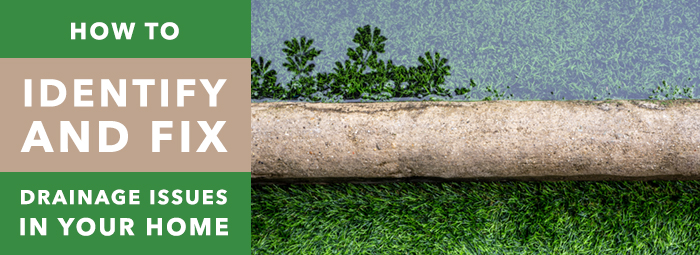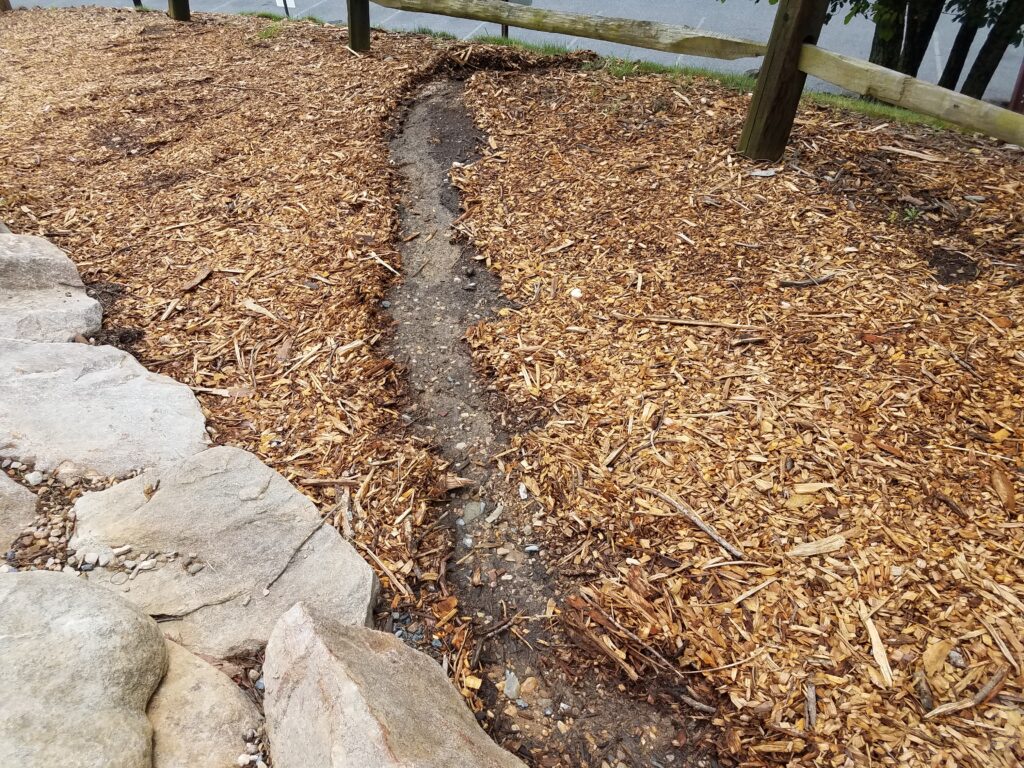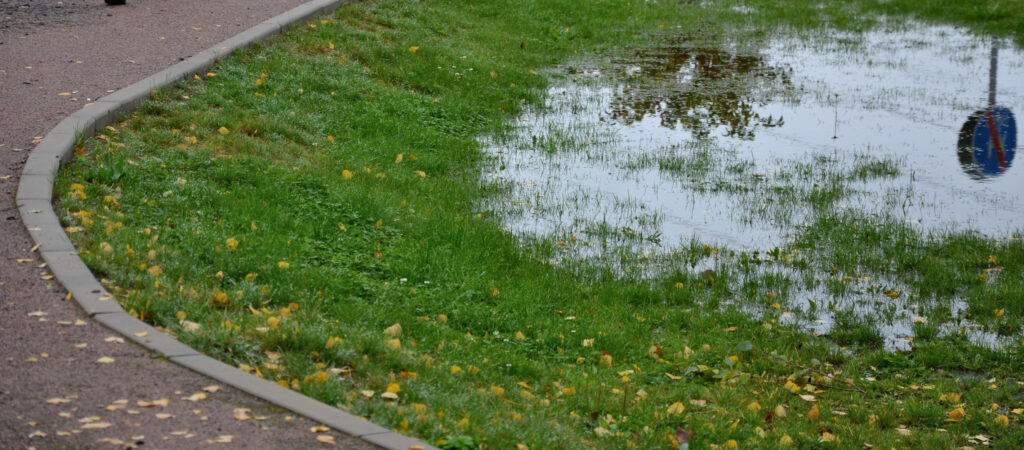
Originally posted on July 2, 2021
If not dealt with, drainage and flooding issues could become a significant concern for property owners. Insufficient drainage within a building might lead to mold development, decay, and damage that impacts both its appearance and structure. External drainage problems can harm the property and create safety hazards.
As the provider of high quality artificial turf, Turf Factory Direct is familiar with the drainage problems associated with grass lawns and artificial turf alike. While artificial turf can be a solution to poor drainage in your yard, drainage issues are one of the few problems that occur with a turf lawn if not properly installed. Continue reading to learn more about how to identify the cause of drainage issues in your home, and how to address them.
10 Signs of Drainage Issues
Ensuring that you’re watching for the telltale signs of drainage issues will help mitigate damages and long term consequences. Some of the most common signs presented with drainage issues may include but are not limited to the following:
1) Water in the Basement
If you have water pooling in your basement, there can be a number of causes, but almost all of them relate to a leak or poor drainage. If the pooling is happening close to foundations or walls, it’s almost certainly a drainage problem.
2) Mosquito Infestation
If you’ve got mosquito infestations, or are having trouble keeping bugs off your patio, that means you’ve probably got some drainage problems. It takes mosquitoes time to multiply, and standing water often gives them the necessary time and conditions, indicating a larger issue.
3) Dead Plants
If your trees and grass are dying or show signs of rot, it probably means that the soil is becoming oversaturated or water is pooling near it. Exposed roots can be an indication of drainage problems because it potentially shows dirt has been washed away.

4) Soil Erosion
Erosion, collapsing soil, or migrating mulch are indications of a drainage problem. When water collects and flows, it takes surrounding material with it, such as top soil, mulch, leaves, and other debris. These can accumulate to form blockages, causing more flooding. This also leaves indentations and an uneven surface, which makes it easy to identify the direction of the flow of water, the source of flooding, and where issues are, such as blockages.
5) Ice Building Up
One of two things usually cause ice buildup: extreme weather conditions that result in an accumulation of snow and ice, or poor drainage. If you’re experiencing a mild or normal winter and sections of your house are having large amounts of ice buildup around the foundation, lawn, garden, patio, or walkways, it likely means you need to correct for some drainage problems.
6) Gushing Gutters
Water gushing over the edge of your gutter means something (most likely dead leaves and debris) is blocking and preventing the flow. Vertical streaks of dirt on the outside of gutters, mud spattered on siding, or paint peeling off the house in vertical strips are other sure signs. If you don’t take action, overflowing gutters can rot siding, ruin paint jobs, and cause structural damage.
7) Dumping Downspouts
Similarly to clogged gutters, a downspout that’s dumping that much water too close to the foundation can send it right into the basement or crawlspace, where it can cause serious damage.
8) Stains and Peeling Paint
Depending on where peeling paint and stains shows up, you can tell if the problem is caused by surface water, or water traveling underground, Surface water can be easier to deal with than underground water. You’ll want to make sure that you have an interior drain system and a sump pump to ensure that your basement is safe and dry.
9) Mold and Mildew
Mildew and mold anywhere in or on a home is a sign of improper ventilation, leaks, or possible drainage issues. Make note of where the mold or mildew is growing. The location is a good indication of where moisture is collecting. This can provide a clue into the source of the moisture, and whether the cause is a leak or a drainage problem.
10) Cracks in the Foundation
Watch for foundation cracks, especially if they’re growing in size and/or number. Small cracks often appear in foundations as houses settle over time. Most are harmless, but bigger cracks can be cause for concern. Measure and record the size and locations of cracks in the foundation. If you notice the cracks are growing, you’ve got potential problems.
5 Causes of Drainage Issues and How to Fix Them
There are a number of factors that can be the cause of drainage issues, and sometimes it can be a combination of them. Similarly, you can apply a combination of methods to address the issues.
Installing an artificial turf lawn is the solution that can remedy or mitigate some of the causes of drainage issues, while also increasing curb appeal and property value, as well as conserving water.
In addition to being durable, versatile, cost effective, and low maintenance, one of the benefits of turf is that following the instructions for the proper turf installation process can resolve some of the causes of drainage issues and prevent them happening in the future:
- Removing excess top soil and vegetation that disrupt the flow of water.
- Grading and leveling the surface to direct water away from the property.
- Spreading aggregate gravel base that provides proper drainage.
- No watering means less water to potentially flood the property.
1) Improperly Installed Downspouts and Gutters
Gutters and downspouts are essential to proper drainage, and without proper installation, they create drainage problems. Ensure that all downspouts are pointed away from the house and that they’re connected to a drainage system. Additionally, make sure you regularly clean the gutters to prevent blockages.

2) Poor Landscaping
Causes of potential drainage problems include:
- Bare soil without vegetation
- A yard that slopes toward your home
- Uneven grading
- Paved surfaces that direct water to the structure
On top of those problems, if you’re watering a grass lawn, you’re potentially adding to the problem by increasing the amount of water accumulating. When your lot isn’t graded properly, water moves toward your house, rather than away from it. If water is collecting in flat areas, you probably have surface depressions. These are divots in your yard area that allow water to puddle and pool, which is a major issue over time.
To address this, try filling in these spots over time or grading them so water drains away from the depression itself. If you continue to have problems, an underground catch basin will be necessary. By adding in drains to collect water and pipe it away, you ensure that water stays away from the home itself.
On the other side of the spectrum, people sometimes use too much topsoil or mulch in their flower beds, or they grade the bed the wrong way when making them. They become raised and slope back toward the house, causing water to run back and into the home. If the gutters overflow, too, then you have real problems.
Be sure the grade of the planting beds is away from the home or structure. French drains, rocks or gravel, and/or planting vegetation will help direct water away and reduce flooding and drainage issues.
3) Soil Issues
If you notice that your lawn is muddy in one spot and dry in the next, it could be the type of soil that is causing drainage problems. There are three basic soil types: sand, silt and clay.
- Sandy soil can cause water to slip right through. If it is sandy right against your home, water will run down the sides of your foundation.
- Contrary to sandy soil, clay soil does not drain well and can cause water to collect.
- Silt is a combination of fine sand, clay, or other material carried by running water and deposited as a sediment. Uneven drainage can occur as a result.
Improving soil with an aggregate is a great way to protect against foundation damage and other drainage problems.
4) Clogged Drain Pipes
Roots getting into drainage pipes can cause them to back up. They not only block the pipe but can completely fill it.
To fix this requires the removal of the pipe, or a root cutting service to mechanically clean the pipe out. After you clean the pipe of roots, be sure to keep roots from squeezing into the pipe. Wrap perforated pipes in filter fabric when they are close to roots, and glue the joints so they are sealed tight.
5) Neighbor Runoff
When you live downhill from other properties, you can often be subjected to their runoff. This is nobody’s fault, but it’s important to address the cause. Creating diversions to reroute water that flows from other folks is an important step to keeping your property clean and safe.
Drainage Solution: Turf Factory Direct
Avoid or fix drainage issues by correctly installing artificial turf! Turf is the solution that can upgrade the comfort, efficiency, and safety of your home, whether it’s your lawn, your roof, or your deck.
At Turf Factory Direct, we can help you pick the best artificial turf for your project (whether it’s landscaping, pet turf, putting green, or batting cages) and make sure that you have the tools and expertise to install it. Get in touch with us today.







